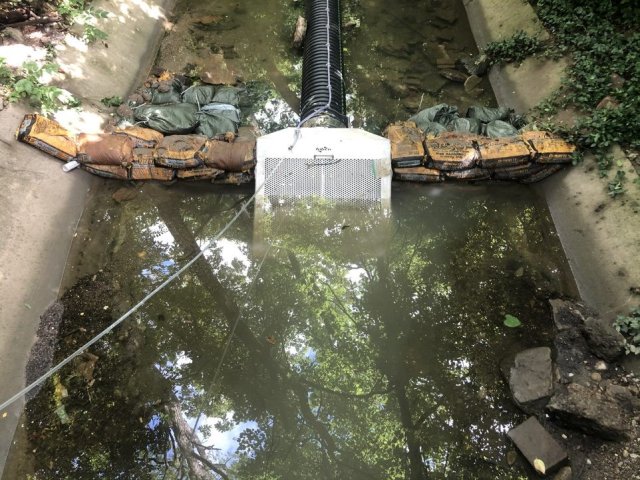Stormwater Management Technologies: Treatment Media
Following contamination of infrastructure, state and local agencies may need to implement control measures to contain or redirect stormwater. EPA is developing and testing technologies to support stormwater management.
Go back to the Stormwater Management Implementation Control Technologies page.
Treatment Media
Stormwater retention/detention basins and sewer outfalls can be important tools to not only contain but to also treat stormwater after a wide area contamination event. Basin and outfall retrofits can include the use of treatment media to remove contamination as water is release from these structures. Water can be routed through these media, which can be packed into piping connected to the basin/outfall retrofit devices. During periods of excessive flow, the retrofits and treatment media can be bypassed to avoid upstream flooding.
The EPA has tested several types of treatment media in its testing and evaluation facility in Cincinnati, Ohio for their ability to remove chemical, biological, and radiological contaminants. The table below summarizes the results. EPA is also working with commercial vendors to test commercial off-the-shelf treatment media for inclusion in retrofit devices.
| Media Description | Nutrients | Radioactive | Bacteria | |||
|---|---|---|---|---|---|---|
| Total N (% Removal) | NH3-N (% Removal) | Total P (% Removal) | PO4-P (% Removal) | Cesium (% Removal) | E. coli (Log Removal) | |
| Coated Gravel | 90.0 | 78.0 | 100.0 | 86.0 | 92.0 | 0.0 |
| Ferric Oxide Powder | 76.0 | 78.0 | 100.0 | 98.0 | 94.0 | 6.0 |
| Switchgrass | 92.0 | 76.0 | 64.0 | 90.0 | 94.0 | 4.0 |
| Activated Carbon | 94.0 | 76.0 | 90.0 | 84.0 | 80.0 | 4.0 |
| Natural Zeolite | 94.0 | 80.0 | 88.0 | 86.0 | 96.0 | 6.0 |
| Granular Ferric Oxide | 66.0 | 74.0 | 100.0 | 100.0 | NT | 2.0 |
| Sintered Metal with Copper | 72.0 | 78.0 | 56.0 | 54.0 | NT | 2.0 |
| Iron Composite Metal | 80.0 | 80.0 | 100.0 | 100.0 | NT | 8.0 |
Cooper Creek Project - Case Study on Stormwater Management and Treatment
The Cooper Creek Collaborative brings together several local and federal agencies, including EPA researchers, as well as state universities and community partners to address urban hydrologic alteration to improve water quality. They are also developing best practices to contain potential contamination in the Cooper Creek Watershed in Cincinnati, Ohio.

As part of this collaborative, EPA and the Hamilton County Soil and Water Conservation District (Ohio) have instituted a joint project at Bechtold Park, Sycamore Township (Ohio), to reduce the peak stormwater flow rates from a storm sewer to improve the stream quality downstream. In addition to reducing the maximum flow rates, adsorbent material will be installed to reduce storm water contamination.
The storm waters collected and discharged to Upper Cooper Creek are mostly from residential areas but E. coli, oil and grease, nutrient loadings, etc. have been observed. The water often smells and has a greyish brown appearance. Sanitary sewer manholes and interceptors are in the area and overflows and leaks are possible. Absorbent media will be used in conjunction with the stormwater control device to treat contamination. During rainfall events, samples will be collected upstream and downstream of the media to determine if the water quality improves after passing through the media.

Currently, the 6-foot stormwater outfall pipe discharges all the collected stormwater very quickly, and with a large sudden volume, during a significant rainfall event. However, during dry periods, there is little or no water supplied to upper Cooper Creek. The stream bed does not go completely dry, but it is difficult for certain beneficial species to survive in such variable flow conditions. The objective of the stormwater control device is to slow down the drainage from the 6-foot outfall pipe into upper Cooper Creek, by leveling out the flow downstream in the creek. A weighted flap gate retrofit was evaluated but was determined to restrict flow to the point of causing upstream flooding. Instead, a vault and spiral coated media filter were chosen for use in this application.
The vault is a two-step treatment process that incorporates an inlet chamber used to reduce clogging from sediments and debris, and a secondary treatment chamber (black plastic piping shown in figure) that houses the spiral coated media filter elements. The filter elements reduces bacteria in the stormwater. The filter system consists of a metal filter screen and a spiral shaped scraper which continuously cleans the screen without the need for backwash or crossflow. The spiral coated media filter system can treat flows of 3 cubic feet per second. Higher storm flows bypass the system and are discharged to the receiving stream. During lower flow events, flow to Cooper Creek is levelized by the creation of a detention basins formed by sandbags across the outfall and the spiral coated media filter system.
New technologies are rapidly being introduced to the water monitoring and flow control market. EPA has worked to develop simple flow gauge devices that push data to the internet such that it can be accessed by any smart phone or tablet. The Bechtold Park study will use both industry standard samplers and flow sensors as well as new innovative devices. The data from these standard and innovative devices will be compared and the results published.
EPA is collaborating with many partners to improve stream quality in Cooper Creek. Results of this collaboration could results in best practices for stream quality that could be widely applied.
